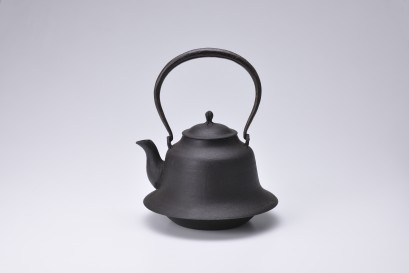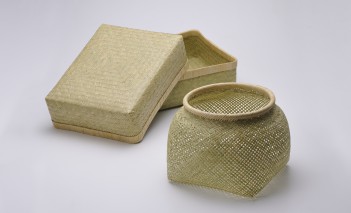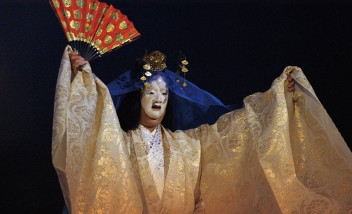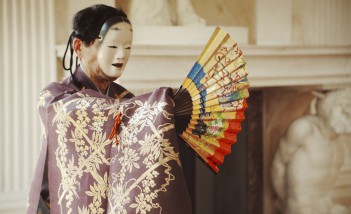Masterpieces of Japanese artistic craft from Tōhoku will be on display in the Royal Łazienki Museum from 2 to 24 March 2019. Visitors will have a chance to see ceramics, textiles, lacquerware as well as objects made of metal, wood and bamboo – their diversity illustrates the unique culture of the region that was destroyed by the great earthquake and tsunami eight years ago.
The exhibition "Tōhoku. Japanese Artistic Craft" will be open to visitors in the Officer Cadets School on Tuesdays and Wednesdays between 09.00 and 16.00, on Thursdays between 10.00 and 20.00, and from Friday to Sunday between 9.00 and 16.00. Entry: full price: PLN 5; reduced – PLN 2.50; on Thursdays, admission is free.
The exhibition has been organized in cooperation with the Japanese Embassy in Poland and the Japan Foundation – on the occasion of the 100th anniversary of diplomatic relations between Poland and Japan. It commemorates the events of 11 March 2011. The eastern coast of the Tōhoku region, known for beautiful mountains and marine landscapes, as well as its rich local culture and history, was devastated by a cataclysm of unprecedented magnitude. The residents of the regions affected by the catastrophe incurred massive losses, also with respect to handicraft and craftwork.
The exhibition presents the special artistic heritage of the Tōhoku region. We will learn about traditional craft techniques and beautiful, functional objects of daily use that will help the audience find appreciation for Japanese aesthetic sensibilities, folk wisdom and manual skills developed by living close to nature.
The presented works include ceramics, textiles, lacquerware and objects made of metal, wood and bamboo. In addition to traditional handiwork, the exhibition will feature works by artists who found inspiration in the beauty of folk crafts and whose art encapsulates the culture and spirit of Tōhoku.
Tōhoku and Artists of the Mingei Movements
In early 20th century, during his visit in Tōhoku, Sōetsu Yanagi – founder of the mingei movement – became fascinated by the beauty of local handicraft. He started collecting utensils and tools found during his visits in various locations in the region. Other influential members of the movement such as potters Kanjirō Kawai and Shōji Hamada, textile designer Keisuke Serizawa and prominent wood engraver Shikō Munakata, were equally impressed by the Tōhoku handicraft.
The artists offered help to the local craftspeople, not just by preserving their traditional projects, but also by creating new ones that gave the local works a degree of modernity. Those initiatives breathed new life into the craft of the Tōhoku region, but – rather ironically – they weakened an important aspect of these works – their anonymous nature – by bringing fame to the artists and places where the handicrafts were made. Nonetheless, the leaders of the mingei movement helped preserve the beautiful handicraft of the Tōhoku region, although changes to the economic structure and the outflow of people to big cities led to a gradual erosion of abilities that had been widely practiced in early 20th century. From the great wealth of crafts that once evolved in the Tōhoku region, the exhibition will mostly focus on the works that are relatively well preserved and techniques that are still used today.
Techniques of the Tōhoku Region
Basket Weaving
In winter, residents of the snowy Tōhoku region craft various types of baskets from bamboo, grapevines and akebia. These items are widely used in everyday life. In addition to being practical, they have undisputed artistic value.
Ceramics
The Japanese pottery industry is very diverse, with each of its regions offering its own local craftwork. Although in comparison to the rest of Japan, there are relatively few places in Tōhoku where ceramics are manufactured, the region does offer beautiful vessels. The exhibition will feature: Aizu-Hongo ceramics (from Aizu-Hongō-chō, Ōnuma-gun, Fukushima prefecture), Naraoka ceramics (from Nangai-mura, Senboku-gun, Akita prefecture) and Tsutsumi ceramics (from Sendai, Miyagi prefecture); those range from the Edo-period objects (1603-1868) to contemporary works.
Embroidery
Kogin is a type of embroidery from a region of the city of Tsugaru in the Aomori prefecture. Initially, the local name of work attire – kogin – referred to indigo-dyed hemp fiber strengthened by white cotton stitches. According to edicts enacted in the Edo period, peasants and farmers were only allowed to wear kimonos made of hemp, not cotton. However, those were not suitable for the harsh winters in Tōhoku. Hence, when cotton threads became available, farmers started to strengthen hemp threads with thick stitches to protect against the cold. Kimonos were mainly crafted by women, who competed to create the most beautiful patterns. There are several styles of kogin in the Tsugaru city region. Those include: Nishi-kogin (western kogin), Higashi-kogin (eastern kogin) and Mishima-kogin.
Weaving
The Tōhoku region has developed a unique culture of crafting materials, even though its dyeing and weaving techniques are limited compared to the leading textile industry centres such as Kioto. Characteristic techniques include Akita Hachijō (dyed cotton) and hand dyeing technique tsutsu-gaki from the Fukushima prefecture.
Bark and Flexible Wood Crafts
Objects made of flexible wood are known for the beautiful, simple layout of threads and the natural aroma of the cedar from Akita. The town of Kakunodate in the Akita prefecture is known for handicrafts made in the kaba-zaiku style: mountain cherry bark placed on wooden base known as mokutai.
Metalworking
The Tōhoku region is known for metal casting. The arare-gama style used to make cast-iron kettles takes its name from the regular protrusions that form a pattern that resembles arare, "hailstones" in Japanese. The habiro cast-iron kettle with a characteristic brim near the bottom was made in Dō-machi in the Yamagata prefecture. Both objects are valued for their expressive shapes.
Painting
The kokeshi dolls, kites, ceremonial dolls and decorated candles (e-rōsoku) are unique works from the Tōhoku region. Not only their shapes, but also the decorative paintings symbolize success and express prayers for safety, happiness and prosperity.
Lacquerware
The Jōbōji lacquerware, featured on the exhibition, was made in Jōbōji in the Tōhoku region, a place famous for the "raw lacquerware". In the surrounding area, the traditional method for extracting resin – urushi-kaki – is still being used. It is done by cutting the surface of lacquer tree in such a way as to protect it against damage.




